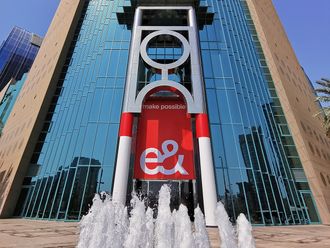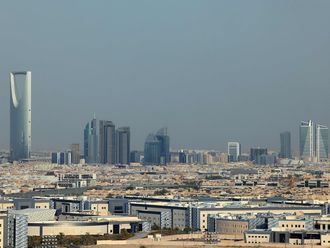Dubai: The US equity indices closed lower (S&P: -0.6 per cent, Dow: -0.8 per cent) last week driven by nervousness around changes in Trump administration and its potential impact on Trump’s pro-business agenda, while US 10-year treasury (10yr UST) closed broadly flat at 2.19 per cent. The 10-year UST rate spiked by over 7 bps on Tuesday on better-than-expected July retail sales (MoM growth: +0.6 per cent vs estimate: +0.3 per cent); however, lost most of the gains on dovish undertone from the FOMC minutes on Wednesday. The FOMC minutes from the July meeting further underscores a potential start of the Fed’s balance sheet normalisation in September, in line with market expectations, but the inflation comments were construed to be on the dovish side. Per the minutes, inflation is running “below” the Fed’s 2 per cent target compared to a previous stance of “somewhat below” target. ECB minutes also came last week, reflecting that growth is expected to remain robust within the euro area, however, concerns were raised on the “limited signs of a sustained upward adjustment in underlying inflation” and potential “risk of the exchange rate [euro] overshooting in the future”. Looking ahead, the markets will be fixated on any cues from the Fed’s annual policy summit at Jackson Hole, where Fed’s Chair Yellen will speak on financial stability, while ECB’s Draghi will also address the meeting but is reportedly unlikely to deliver any new policy message.
Mixed note
Last week, the major regional equity markets ended on a mixed note, with Dubai (DFM), Abu Dhabi (ADX) and Qatar (QE) ending lower by minus 1.3 per cent, minus 1.3 per cent and minus 1.5 per cent, respectively. The Saudi index (SASEIDX) and Kuwait (KSE) continue to outperform the regional indices, and ended higher by 0.2 per cent and 0.6 per cent, respectively. The timeline for reporting second quarter earnings ended last week, with all DFM companies reporting on time, while 1 company within the Abu Dhabi index and 2 companies within the Saudi index didn’t report numbers on time. For the DFM, the consolidated earnings came lower by 31 per cent year-on-year (YoY) and 27 per cent quarter-on-quarter (QoQ), however, adjusting for non-recurring fair value loss of Dh2 billion on investment properties by Union Properties, the earnings were up 2 per cent YoY and 8 per cent QoQ, respectively. Among the heavyweights, Emaar reported earnings ahead of market expectations by 7 per cent, and we look forward to a planned analyst meeting this week to get better insights on the development portfolio and planned unit IPO in the fourth quarter.
Damac cancellation of units
Damac reported earnings came 16 per cent below market expectations, and the reported earnings were partly supported by income from units’ cancellation (equivalent to 18 per cent of the reported net income). Looking ahead, management expects much-lower income from cancellation of units on a recurring basis and expects to purchase a sizeable land bank in the near future. The management also reiterated its guidance of Dh7 billion in contracted sales for 2017 (2016: Dh7 billion) and suggested that they have a “cautiously optimistic” outlook on Dubai real estate market in the medium-term. The stock declined 3 per cent last week, and we await any catalyst in the stock before revising our cautious stance on the counter at current valuation. Within the UAE REITs space, ENBD REIT held its first investors’ call post listing in March 2017. Since listing, the company has completed acquisitions worth $48 million (Dh176 million) (out of net $102 million IPO proceeds) and we consider that the material deployment of IPO proceeds (and leverage on the equity) will dictate the stock price trajectory in the medium-term.
Marka loss
Marka reported its 11th consecutive quarterly loss in the second quarter, which took the stock price to its lowest level (Dh0.665) since listing in the fourth quarter of 2014. Reported loss for the second quarter of 2017 came to Dh126 million (vs the loss in the first quarter of 2017 at Dh28mn), and was partly driven by Dh55 million impairment in the quarter. The company pointed out that it has commenced corporate restructuring with an aim of exiting underperforming businesses, while continuing its regional expansion for a strong food and beverage (F&B) portfolio. The company’s equity currently stands at Dh137 million (accumulated losses are at Dh361 million), with short-term debt repayment obligations of Dh200 million, and we expect potential financing needs in the near-future. The company’s shareholders have already approved, on April 30, 2017, the Board of Directors’ recommendation to increase the authorised capital to Dh1 billion (from Dh500 million), and we consider this to be a lingering risk on the share price. Thus, although we expect some technical bounce in the stock price, we remain on the sidelines and await more clarity on the planned restructuring and potential equity raise.
Abu Dhabi
For ADX, the reported earnings represented a growth of 20 per cent (YoY) and a decline of 9 per cent QoQ in the second quarter; however, adjusting for Gulf Medical Projects Company (GMPC) one-off gain in the first quarter, earnings were up 7 per cent QoQ. In Saudi Arabia, Saudi Cable and Alujain didn’t report numbers on time, with Saudi Cable advising the market that the delay was due to non-filing of 2016 annual financials, and it expects to file the financials within 8 weeks. Alujain announced that the delay is primarily due to lack of approval by the Extraordinary General Assembly on the appointment of the external auditor for 2017. We will look forward to Alujain’s second quarter to get a better colour on potential impairment on the company’s JV, Bonar Natpet Company, which the company’s subsidiary (NATPET) has provided an interest free loan as well to meet refinancing needs.
Regional credit markets outlook: expected to remain firm
The GCC credit markets were mixed last week, with Qatar and Oman seeing better bids. We saw some optimism on the Qatar curve after news that Saudi Arabia will permit Haj pilgrims to cross the border moved the curve tighter by 3-5 bps. The Saudi curve had mixed interest with better buyers on the short-end but limited interest on the long-end, translating into the curve steepening by about 8 bps — with global rates lower and oil prices holding firm, we would look to add to the long-end of the curve. Within the high-yield space, our desk was focused on EA Partners (EAPART), Dana Gas and Damac Properties. EAPART bonds dropped about 8 points around 87 on both those due in 2020 and 2021 after Air Berlin announced its insolvency, whose share stands at 18.85 per cent for 2020 and 19.9 per cent for 2021, respectively. We expect volatility to persist on the curve with investors unclear of the outcome of a potential “Remarketing event”. The coupon payment on both bonds is due in September, which we expect to be honoured with the “liquidity pools” holding enough cash.
Dana Gas drop
Dana Gas held a second quarter earnings call last week but didn’t take any questions on Sukuk, pending litigation, but a statement on potential “significant liability for the Sukukholders” led the bonds to drop further by 4 points to 71 levels. Overall, the announced second quarter earnings had some positives on Egyptian operations — production increased by 3 per cent YoY, although there was some planned maintenance, and the company collected $122 million during the second quarter leading to Egypt’s outstanding receivables declining to $189 million (fourth quarter of 2016: $265 million). However, the UAE operations continue to disappoint and the management highlighted potential restructuring of the UAE operations, which we expect to translate into some write-offs. Net-net, the company’s future remain hinged to favourable outcome on undergoing litigations, and we expect the third quarter to be a busy period for the company — with an update expected on quantification of the damages under the London Court of International Arbitration (LCIA) third-partial final award, injunction on Sukuk in the UK court, and planned referendum in Kurdistan.
Cash flow position
Damac highlighted in its earnings call that its cash position remains healthy, and the company aims to reduce its total debt to $1.3 billion (from $1.46 billion) by year-end. However, we consider that the run-up in its recently issued bonds (Damac 22s issued at 6.25 per cent yield, currently trading at 5.2 per cent yield) more-than-reflects its underlying cash flow position. Accordingly, within the UAE real estate market, our desk now prefers exposure to Meraas due in 2022, yielding 4.7 per cent, compared to Damac due in 2022 on risk-adjusted basis.
Ankit Gupta is a CFA from SHUAA Investment Management team. He can be reached at im@shuaa.com












